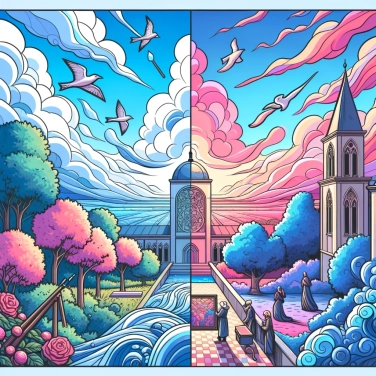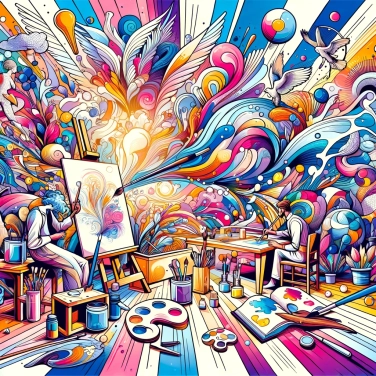The technique of perspective revolutionized artistic representation during the Renaissance by allowing the creation of the illusion of depth and distance in works, thus offering a more detailed and immersive realism for viewers.

Before the Renaissance, representing a 3D space realistically was more about artistic intuition than about precise techniques. But in the 15th century, artists like Brunelleschi began to use geometry and mathematics to create a credible illusion of depth to the eye. This is known as linear perspective, a simple method that involves making all the lines in a scene converge towards a single point, called the vanishing point. This mathematical principle allows paintings to become true windows into the real world, marking an original meeting between art and science. Painters no longer just have an artistic eye; they must now think like scientists, measure angles precisely, master basic geometric concepts, and observe reality closely to better reproduce it. Treatises, like the one written by Alberti, detail precisely how to achieve this visual magic by following clear and reproducible rules. All these advances make perspective an original blend of mathematics, observation, and artistic creativity.
Before the Renaissance, artworks often lacked realism and had strange proportions or perspectives. From this period onwards, the scientific use of perspective allowed for a true "visual deception": it creates the impression of coherent and natural depth by projecting all lines towards one or more vanishing points. The result? For the first time, the viewer has a concrete feeling of looking through a real window open to a realistic world. Thanks to this illusion of three-dimensional space, characters and settings gain density and relief; in short, the scene becomes incredibly credible and immersive. Leonardo da Vinci and Masaccio particularly play on these effects, pushing their work towards striking, almost photographic realism long before the invention of photography itself.
With the emergence of perspective, artists completely transform the way they organize their scenes. Gone are the characters arranged randomly or awkwardly aligned flat: now, every detail finds its precise place in a clearly structured space. Artists willingly adopt the division into different planes (foreground, background), giving true depth to what they depict. This depth allows the eye to move naturally and to perceive the space as if it were real, almost inviting the viewer to enter the work. Dynamic compositions appear, where guiding lines often converge towards a vanishing point, creating a harmonious and natural balance.
Thanks to the new mastery of perspective, artists were able to tell stories that were much more vivid, coherent, and immersive. Previously, characters often seemed to float without a precise anchor in space. Now, it became possible to accurately arrange positions, distances, and movements, which gave much more credibility to the scene. As a result, the interactions were immediately understandable, and the entire narrative became quick and intuitive to grasp. The use of a central vanishing point also allowed painters to naturally draw the viewer's attention to the key elements of the story. Consequently, by gazing at a work, one would "live" the action directly, much like entering a movie.
The mastery of perspective changed the way man situated himself in the world: from a simple passive spectator, he became a conscious observer, capable of measuring, calculating, and understanding his environment. This stimulated scientific curiosity, pushing people to want to explore and experiment. We shifted from a religious, symbolic, and rather closed vision to a more rational approach based on observable facts. Gradually, this visual revolution encouraged a new way of thinking, placing human beings and their individual perception at the heart of intellectual and social concerns. This is one of the important foundations of what would later be called humanism.
Did you know that Leonardo da Vinci was one of the first artists to delve into the scientific study of atmospheric perspective? This discovery allows for the creation of an effect of depth through variations in color and contrast as one moves further away in the landscape.
Did you know that linear perspective, put into practice by the architect and artist Filippo Brunelleschi, is largely based on mathematics and geometry? He conducted his first experiments on the Florence Cathedral in the early 15th century to demonstrate its principles.
Did you know that the fresco titled 'The Trinity' by Masaccio (1425-1427) is considered the first masterpiece to rigorously apply central perspective? It represents a true artistic revolution in the way space and reality were depicted at the beginning of the Renaissance.
Did you know that the invention and refinement of perspective during the Renaissance also influenced theater, set design, and even urban architecture, by offering new possibilities for the realistic representation of visual and scenic spaces?
The medieval perspective often prioritized the size of figures based on their spiritual or symbolic importance, ignoring a realistic representation of space. In contrast, Renaissance perspective adopts a realistic and harmonious representation, adhering to a spatial unity based on the mathematical principles characteristic of the 16th century.
Among the pioneering artists who significantly contributed to the evolution of perspective principles are Filippo Brunelleschi, Masaccio, Leonardo da Vinci, Albrecht Dürer, and Piero della Francesca. They established the theoretical and practical foundations of this technique.
The mastery of perspective marks a significant turning point in art and science, as it reflects an increased desire to observe nature accurately, to understand its rules, and to faithfully represent the sensory world. This leads to a heightened dialogue between artists and scientists, contributing to the intellectual flourishing characteristic of the era.
No, even though painting was the main medium for popularizing perspective, this technique was also used in architecture to design and represent buildings. Furthermore, it influenced technical drawing, theatrical set design, and later the art of cartography.
Linear perspective is an artistic technique developed during the Renaissance that involves representing three-dimensional space on a flat surface according to strict geometric principles. This method creates a realistic illusion of depth converging towards a vanishing point.

No one has answered this quiz yet, be the first!' :-)
Question 1/5